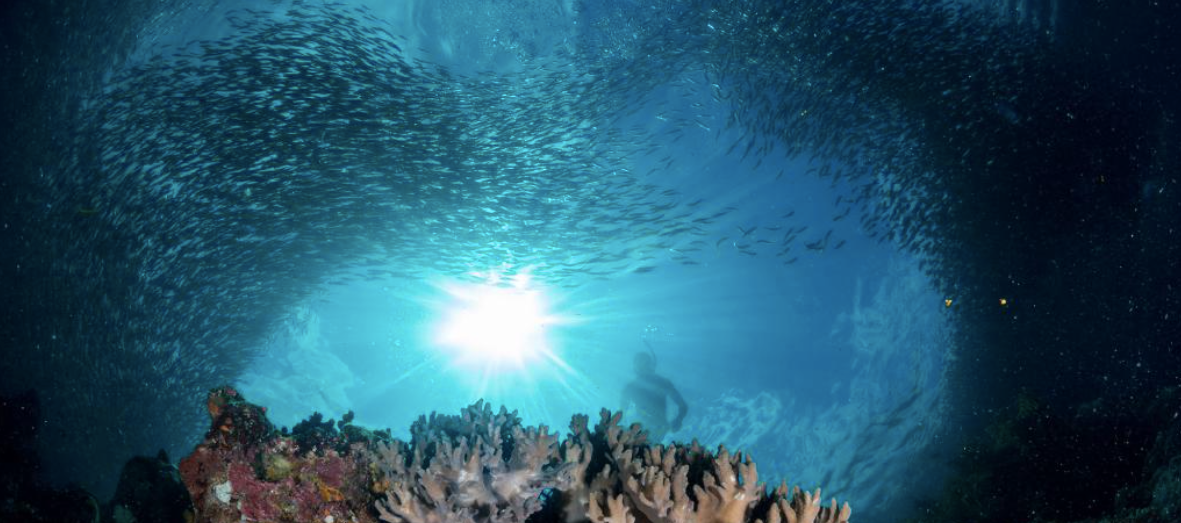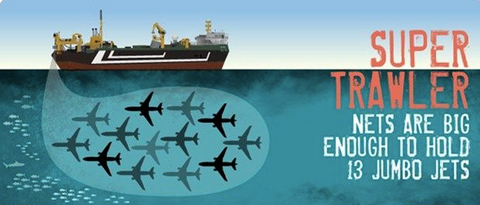
The beautiful ocean. I can’t tell you how much I cherish and covet every moment I spend near it, gazing at it or swimming in it. No matter where I am in the world, it’s magnetic pull and magical draw is a constant for me. Covering 70% of the planet, it shelters an incredible diversity of life, giving us more than half of the oxygen we breathe. Amazing.
As the owner of a food company, I ought to celebrate the rising demand for fish, yet I'm deeply conflicted by many of the fishing industry practices. I'd love people to have an understanding of the facts in order to make better choices when buying seafood products.

Let me give you an example. I took a call from a customer last week, a lovely guy who’d heard great things about our Mt. Cook Salmon. He really wanted to try it, but he was bothered that Mt. Cook is farmed salmon and not wild caught. We had quite a long and insightful conversation. I explained my reasons for stocking sustainable farmed fish, and by the end of the call, he totally got it and happily placed his Mt. Cook order. His parting words were, “I just never understood...”, which got me thinking about my next blog.
I'm proud to offer customers choice, be that farmed or wild-caught seafood products, but my consistent position is it's got to be sustainably produced. Therein lies the most important differentiator, and one which I know allows me to feel at ease with what I sell here at Sasha's Fine Foods. With that in mind, I hope this blog will allow you a better understanding of the different options on the market.
THE HEADLINES
I am staggered by the state of play in today's seafood landscape. The statistics are depressing but a few really stuck in my head as I was researching the topic. In 2016, we each consumed over 20kg of fish, with 170 billion metric tonnes of wild fish and shellfish caught to meet this demand. However, a staggering 40% of all global wild-caught seafood consists of whales, dolphins and turtles. These are inadvertently killed as bycatch - the accidental catching of unwanted fish when commercial fishermen are targeting a different species. This represents an estimated 7.3 million tonnes of "accidental" catch each year. The National Geographic grimly predicted in a recent study that if fishing rates continue in this vein, all the world’s fisheries will have collapsed by the year 2048. The final stand-out for me was reading that in the last 50 years, humans have wiped out 90 percent of the ocean’s top “apex” fish including bluefin tuna, sharks, swordfish, marlin, king mackerel and king salmon.
Like the guy I spoke to last week, I feel I need to explain why I believe eating non-sustainable fish is the wrong way to go, and also why I am supporting the aquaculture movement.

WILD-CAUGHT FISH - A "TAIL" OF TWO STORIES
1. THE BAD - Wild-Caught Non-Sustainable Commercial Fish: massive volumes of fish and other seafood are caught by large companies for vast commercial profit. These companies provide the majority of seafood to many countries around the world, and most fisheries who work for and with these companies often have to pursue fish far into the ocean using increasingly large vessels known as super-trawlers - the juggernauts of the ocean - which are vessels that are mercilessly destructive. Imagine a fishing boat the size of the Sydney Opera House and you will get the picture of what we're talking about.

With onboard processing and packing plants, and preservation systems, their huge engines allow the ship to drag their enormous nets through the ocean. Disrupting fragile marine ecosystems, they leave nothing behind except an oily film on the water, fishing to the point of major population decline and devastating the ocean ecosystem.
Following the arrival of the Dutch owned super trawler, the FV Margiris in New Zealand waters a few years ago, The Conversation wrote that "These super trawlers are boats that should never have been built. They are anti-sustainable in design and devastating in their implementation..".
If you're interested in understanding the huge variety of fishing methods beyond the super-trawlers, here's a great visual of how commercial fisheries capture their products around the world. I also love this amazing speech by the actor Sam Waterston which he delivered in New York earlier this month, “If only fish could write,” he said, “they’d have some choice words.”.
And Singapore?
Just visit your supermarket fish counter, freezer or wet market and you'll find all the wild-caught fish you could ever want. Glistening, gorgeous BUT more likely than not, sourced from one of the large commercial fisheries described above....but hey, it's "wild caught", and that's supposed to be the best, right?
The fisheries companies who bring us these products are essentially mass-fishing with no sustainable practices, harming our health, creating pollution, destroying ocean ecosystems, wreaking environmental damage and often abusing the human rights of the men, women and children they employ. Human trafficking is cited as the life-blood of the commercial fishing industry and identified as a significant contributor to the global incidence of modern slavery in 47 countries.
2. THE GOOD - Wild-Caught Sustainable Fish: the good news is that we now have more sustainable wild-caught fish in Singapore than ever before. Classifying sustainable wild caught seafood depends on multiple factors, including its growth and reproductive rate, the population size and the way in which it is caught. Generally, sustainable fisheries target species that have a low probability of being overfished, either because their populations are healthy or because they grow very quickly and reproduce at a young age. Additionally, fish is considered more sustainable if caught using fishing techniques that produce little to no bycatch and does not harm the surrounding marine environment.
Importantly, there are globally recognised standards and regulations that apply to wild-caught sustainable seafood which is usually certified by a recognised global expert authority like the Marine Stewardship Council. Fishing activity by sustainable certified fisheries has been managed carefully so that other species and habitats within the ecosystem remain healthy and unharmed. These fisheries and their practices are audited annually and comply with marine law. They are 100% on-board with the sustainability ethos, open and willing to invest in and adapt to changing environmental circumstances and regulations. This is the fish we should be buying.
To put it simply, there are good (sustainable) and bad (environmentally destructive) ways to catch wild fish. Don't get duped into buying fish that's simply labelled "Wild Caught" - it's devastating to the oceans, which in turn is devastating to our planet if it hasn't been caught sustainably.
I love this short video - it captures everything you need to know (and is also great for younger people).
SASHA'S FINE FOODS & SUSTAINABLE WILD CAUGHT FISH
I sell SUSTAINABLE wild-caught fish. I also sell SUSTAINABLE farmed salmon because I have full confidence in the fisheries from whom I buy. Having spent more time sourcing sustainable seafood than any other product range, I've learned all the ins and outs of certification and accreditation so I am confident that I'm not doing any harm. I also know the best suppliers in the market, from the North Atlantic to the South Pacific, having personally visited each and every one of them. These are sustainable fishers and farmers that are considered amongst the finest in the world. I trust them, I love their products and I respect their achievements and commitments to sustainable fishing practices.
My preference is for fishing methods like traditional hook and line, where the fish are caught one at a time, avoiding bycatch. A line-caught fish is a superior product and is the most premium quality fish on the market. No fish is handled with more care from the time it leaves the water until it is delivered to a customer than a line-caught fish.
DOES SINGAPORE HAVE THE APPETITE TO DO THE RIGHT THING?
This is a really interesting one. You'll be unsurprised to read that Singapore consumes massive amounts of seafood with each person consuming about 22kg a year. But Channel News Asia reports consumers are making really poor choices; the World Wildlife Fund (WWF) recently called out fish lovers in Singapore, stating that 3 out of 4 common fish species consumed here are not responsibly caught. Poor customer education, limited sustainable fish choices and a heavily price-fixated market have created a dis-engaged consumer. However, those days may be limited. The WWF Singapore has stepped up in a big way, launching a massive drive to educate us on what's available locally and how to go about buying sustainable fish. The Singapore Seafood Guide is a superb piece of work, using an internationally agreed method to assess seafood sustainability. It groups some of the most popular seafood species in Singapore into three categories:
-
Recommended: Seafood species from well-managed, sustainable stocks which are not considered to be over-exploited.
-
Think Twice: Seafood species from fisheries that are at risk of becoming unsustainable, due to management, environmental or stock issues. Only eat these species occasionally, if recommended options are not available.
-
Avoid: Seafood considered to be over-exploited, or from unsustainable, overfished and poorly managed fisheries.
I am truly heartened to see the huge increase in awareness and media coverage locally. A year or two back, this was never mainstream news, so to see regular features now appearing on our screens is a massive step forward. Singapore consumers are even taking to letter writing and calling for the mandatory sale of sustainable-only fish in wet markets! We all take our food seriously in Singapore and I know consumers are increasingly concerned about provenance and sustainability. Driven by local demand, we will see a shift, with suppliers being forced to reduce or eliminate the unsustainable fish we see crowding our shelves today.
Click the image here to download the MSC Seafood Watch app which is a really handy tool to have if you're at the market and unsure about which fish you can responsibly enjoy.
Right now, about half of the yearly global catch of seafood is wild caught, coming from direct harvesting of the oceans by way of massive overfishing, a terrible toll from bycatch, a widespread lack of regulation and enforcement, and massive human rights violations such as slavery. Can we really ignore these facts, and still feel ok about buying products we know to be so detrimental to our planet?
We all want seafood….cod, snapper, tuna, barramundi, prawns, scallops…there isn’t a dietician or a healthcare professional who won’t encourage the eating of seafood. However, choosing to buy wild caught fish, when sustainable alternatives are readily availably, is hard to defend.
THE FINAL WORD
Let’s not forget, Mother Nature gives us wild fish, but it isn’t our right to harvest it all. If our growing population wants to keep eating fish, and I certainly do, the future is sustainable seafood, wild caught or farmed. I hope you'll join me and take a few seconds to ensure that what's going into your shopping basket is allowing you be part of the solution and not the problem.




